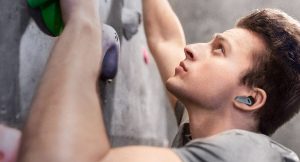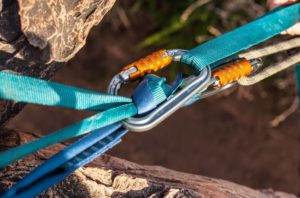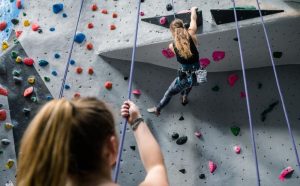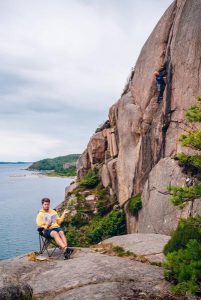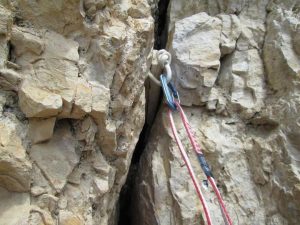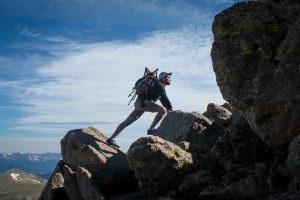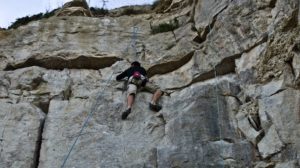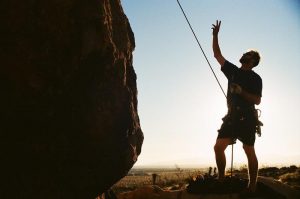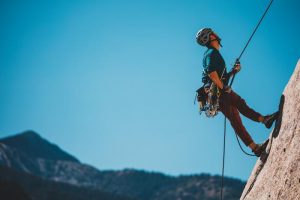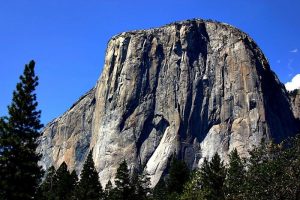What are the best climbing approach shoes? We compared eight of the most popular models side-by-side this past winter: bouldering and sport climbing in Bishop, scrambling and trad climbing in Joshua Tree, and getting up, down, and around Red Rock Canyon. We have abused countless pairs over the years, from El Cap ascents to the summits of the High Sierra, the Rockies, and beyond. Our review metrics – climbing ability, comfort, support, weight/packability, and durability – reward contenders that both climb and hike well.
Best Overall Approach Shoes: Five Ten Guide Tennie
The Five Ten Guide Tennie is our best overall approach shoe. It delivers the best combination of climbing ability and comfort for hiking and scrambling. Five Ten’s recent redesign of this time-tested classic hikes better than its predecessor and maintains most of the climbing performance it is famous for.
The sticky rubber toe rand protects more of the upper than it did in the past, and the updated Stealth C4 Dot sole provides both better traction for sandy hiking, and better edging if you are sizing them snugly for climbing performance.
The Guide Tennie has long been a favorite of climbers who spend lots of time in Joshua Tree National Park, where the approaches to, and descents from, the climbing routes can be more hair-raising than the climbs themselves. It excels in this terrain, and the increased midsole cushioning makes the Guide Tennie hike better than ever. If we could only buy one shoe for an endless climbing road-trip, this is it.
Best Value: La Sportiva Boulder X
As always, our best value pick is the one that delivers the most bang for your buck. The La Sportiva Boulder X is relatively affordable, climbs well, and is better suited to covering long miles on big approaches than any of the models with similar or better climbing ability scores.
Additionally, the lacing system that extends around the back of the ankle provides a great fit for a variety of foot shapes. While the Boulder X is quite a bit heavier than the Guide Tennie, this translates to increased durability and a midsole that supports the foot much better when carrying heavy loads.
Top Pick for Casual, Lightweight Shoe: Evolv Cruzer
We picked the featherweight Evolv Cruzer our best lightweight shoe. This barely-there shoe could be likened to a bedroom slipper with sticky rubber for climbing. Sized to fit snugly, the Cruzer climbs surprisingly well.
Even though it’s not as durable as other models, there are compelling use cases for the Cruzer. Clipped to your harness or stashed in your small climbing pack, these are awesome for toting up multi-pitch routes for the descent.
For long routes where the approaches are relatively short, and the descents often involve slabby down-climbing, the Cruzer rocks. And while this is a lace-up shoe that can be cinched up on your midfoot when desired, the heel portion can also be folded down to the footbed for slip-on entry.
We love this feature for quickly bouncing around the boulders and sport crag. Available in several colors, including a tan and gray, this is the most unassuming looking shoe for casual wear as well.

Durable Upper Materials
In general, approach shoes’ uppers are constructed with materials that are more capable of withstanding the abuse of scuffing against and grinding into the rock. A full leather upper, with the toe covered by a thin, sticky rubber cap, or rand, is a necessity for the longevity of shoes that get crammed into cracks or scuffed against talus and scree.
This article discusses what type of footwear to choose for getting to and from climbing areas, and a discussion of sizing your approach shoes appropriately for climbing performance, hiking comfort, or the best combination of the two.
Easy Alpine Rock Climbs
The La Sportiva Boulder X is a great shoe for these routes as well; it smears much better. You’ll appreciate that on the Friction Pitch of the Upper Exum. Two products we reviewed in other categories, the Salewa Wildfire GTX, a hybrid running/hiking/approach shoe, and the Asolo Jumla GV, a mid-cut hiking/approach hybrid, are great choices for these big days too. If you loved the discontinued Exum Ridge from La Sportiva, check out the Salewa Wildfire as a replacement, we love it.
Do not hesitate to carry a pair of real climbing shoes with you to routes like these; the confidence gained on more challenging pitches can be more important than saving a pound on the approach.
Descent Shoes
Some climbing areas have relatively short approaches and longer descents that involve steep, semi-technical terrain. While some climbers are comfortable descending barefoot or wear climbing shoes that are comfortable enough to descend in, most carry a pair of shoes up the climb to wear on the descent.
A very light, sticky approach shoe fits the bill perfectly. For climbing multi-pitch routes in Tuolumne Meadows, Eldorado Canyon, or Lover’s Leap, we prefer a light, compact model. The Evolv Cruzer is a perfect descent shoe for the friction slabs in Tuolumne Meadows. Clipped to your harness or stashed in the second’s pack, they’re hardly noticeable.
The Vasque Grand Traverse is only a bit heavier but hikes much better. It is a perfect option for Eldorado Canyon or Lover’s Leap. These two shoes are the least durable we tested, and the Scarpa Mojito is a great option for those that want a light shoe that is more durable. Not everyone is that concerned about weight, and the Guide Tennie and Boulder X will support your feet better.
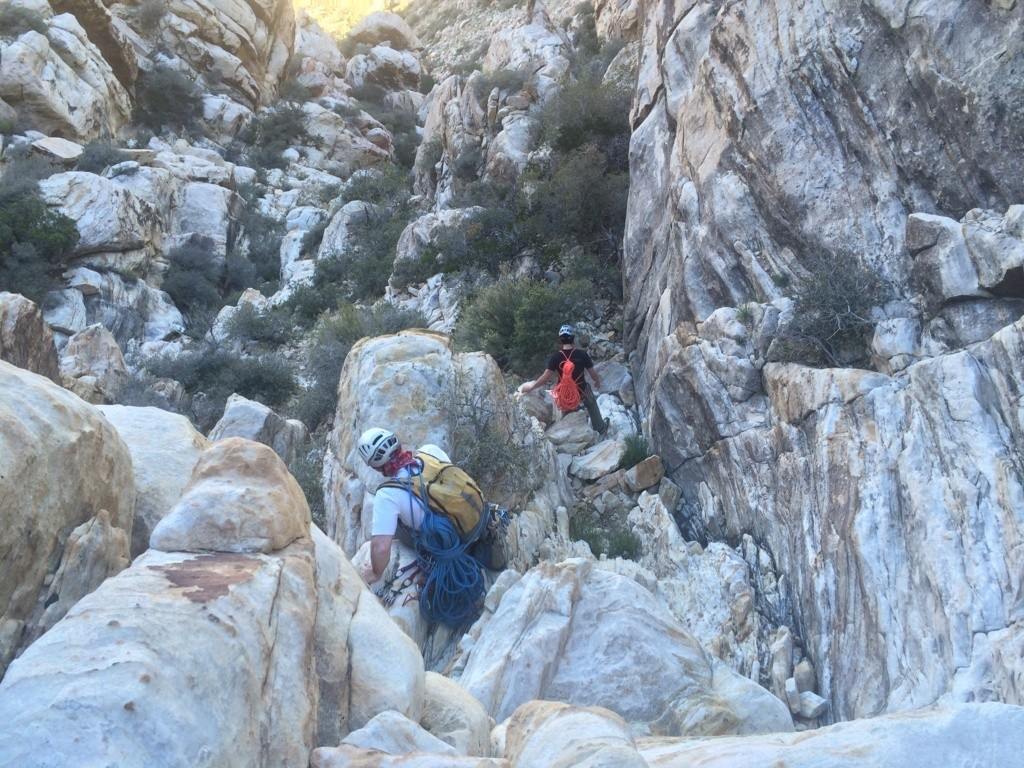
Climbing Ability
Our favorite pick here is the Five Ten Guide Tennie. The La Sportiva Boulder X and Evolv Cruzer fill out second and third places for overall climbing ability. While the other three models maintain much of their climbing performance when sized appropriately for hiking, the slipper-like Cruzer climbs much better when sized to fit fairly snug.
Best Edging
- Guide Tennie
- Mountain Trainer
- Boulder X
- Cruzer
Best Smearing
- Guide Tennie,
- Cruzer,
- Boulder X,
- Grand Traverse
Best Crack Climbing
- Boulder X,
- Cruzer,
- Guide Tennie,
- Mojito
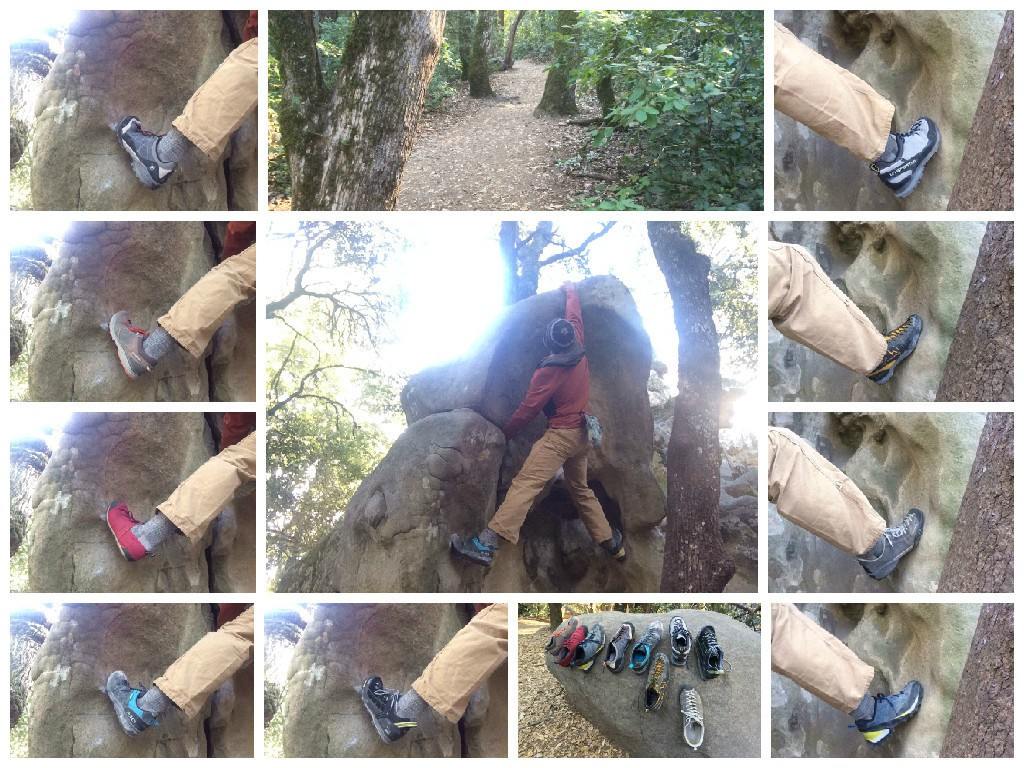
Comfort
Many of these shoes have lacing that extends closer to the toe of the shoe than hiking and running shoes, allowing you to cinch down the toe of the shoe for climbing performance, or loosen it for increased hiking comfort. We also discuss small features such as gusseted tongues, present in both Five Ten models, that help keep sand and debris out, and will save you from an instant soaking when stepping in shallow water. In addition, some models breathe better than others in hot weather.
Support
The Salewa Mountain Trainer GTX is the stiffest, most supportive product we tested. It is an excellent shoe for carrying loads into the mountains. The La Sportiva Boulder X, Five Ten Camp Four, and Scarpa Zen all offer similar foot support. The barely-there Evolv Cruzer is the least supportive of the bunch.
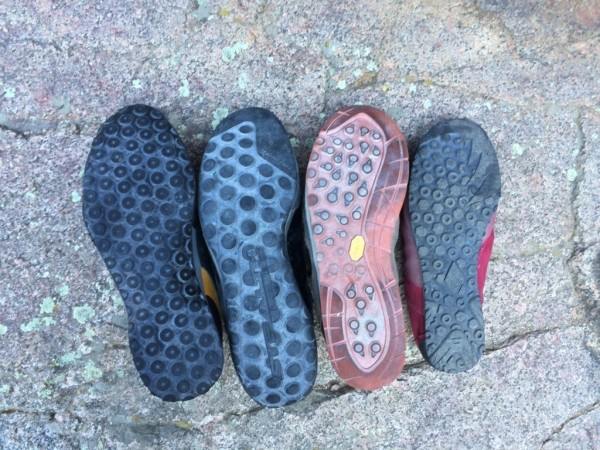
Durability
As we’ve discussed, increased durability to abrasion in rocky terrain is one of two defining attributes of this category of footwear. The uppers of all these shoes, save the Cruzer and to a lesser extent the Grand Traverse, will stand up to much more rocky abuse than the runners and hikers reviewed in our Trail Running Shoes and Hiking Shoes reviews.
Durability scores account for 15% of overall scores.
We judged the Salewa Mountain Trainer GTX to be the most durable product we tested. It is a much more substantial shoe than most we tested. The Scarpa Zen is the next most durable. However, all shoes will suffer wear and tear on the upper materials if used repeatedly in a highly abrasive environment like Joshua Tree. Jamming in the flared cracks there can quickly wear a hole in the upper on the outside of the shoe just behind the toe rand. You can help prevent this by reinforcing this area.
We have refrained from judging the durability of the sticky rubber soles of these shoes. The type of rock you climb on and your foot strike while hiking strongly influence how fast the soles wear down. It is a reasonable assumption that the shoes we found best at smearing have soles that wear more quickly than the others. All of these softer rubber formulations will wear down very quickly if you make a habit of wearing them on pavement or concrete. Minimize this to increase their lifespan. Most of these models can be resoled when the rubber sole wears thin. Resoling climbing shoes is a specialty task performed by only a few shops. We recommend consulting your resoling guru to find out if they are willing to resole a particular model if that is a deciding factor for you.
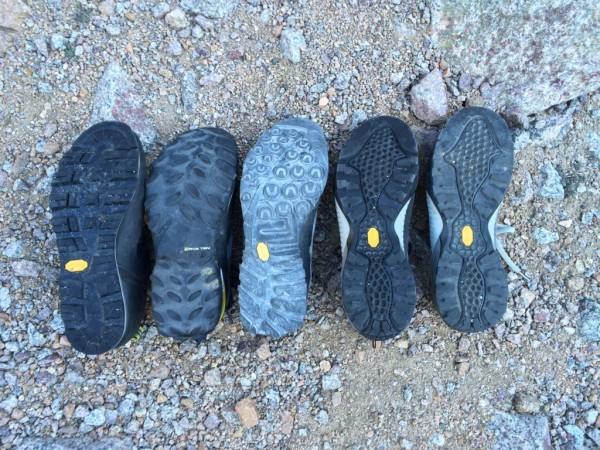
Key Accessories
- SilNet Silicone Seam Sealer
- MICROspikes
- Superfeet Green Premium Insoles
What is an Approach Shoe?
Rock climbing is full of mysterious and technical lingo that is understandably confusing to a new climber or an outsider listening in on a conversation about it. More than once, family and friends have remarked that they understood little of what I was saying other than the fact that I was rock climbing.
They usually then assume this was in some far away, high up and dangerous location (I will just say here that rock climbing is actually quite safe when done properly and accidents are quite rare in the big picture).
So when climbers start talking about ‘approach shoes’ it is easy to understand how this might be confusing; “What is an approach shoe? Why is that different from a normal shoe? What are you approaching?”
The term is actually just a fancy way to describe a minimalist hiking shoe. The name comes from the idea that this shoe is not specifically a climbing shoe but is for getting to the climb. The understanding is that when you get to the climb you will change into an actual ‘climbing shoe.’
However, getting to a rock climb is rarely without some aspect of scrambling and climbing, maybe across boulders or over the easier terrain that brings you to the start of the actual rock climb. So these shoes are made with some extra attention to specific details to make this much easier. These details set them apart from a normal running or walking shoe and make them far superior, even for a casual hiker or climber.
If you have ever found yourself out for a hike in a pair of regular running shoes, perhaps somewhere with boulders and steep slabs of rock, you probably noticed that try as you might your regular shoes don’t want to stick to the slick rock. Well, it turns out that this is actually not so much because of ‘slick rock’ as it is because of slick non-sticky rubber!
The first major characteristic of these shoes is that they are made with special ‘sticky rubber.’ This rubber has far more ‘grip’ than regular shoe rubber, it is soft and pliable, yet durable and abrasion resistant. In fact, it is just a small step from magical, sticky rubber will solve your slippery feet problem when hiking on rocks and boulders, which is the exact terrain you find when ‘approaching’ a rock climb, hence the name!
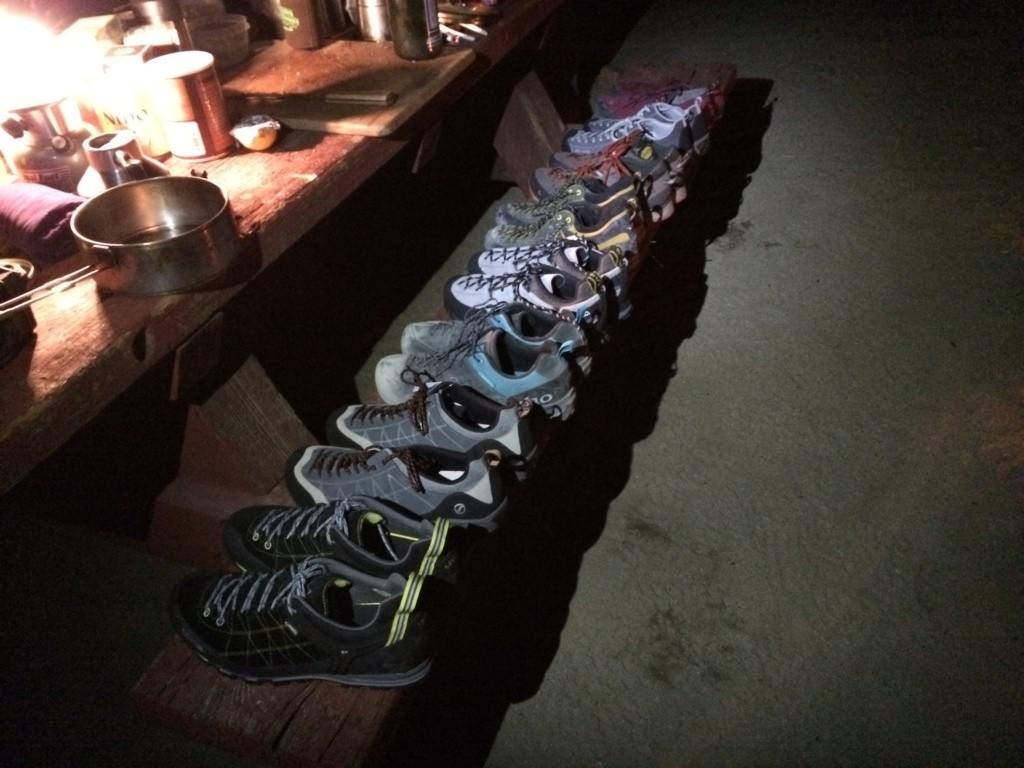
The History of the Approach Shoe
This sticky rubber has a long history dating back to about 1935 when Italian mountaineer Vitale Bramani wanted better footwear for climbing and hiking the Alps. A tragic accident claimed the lives of six of his friends and was widely associated with the poor footwear of the era being used on technical climbing terrain. Bramani teamed with the founder of Pirelli Tires, Leopold Pirelli, to create Vibram soles, the first rubber lugged sole for boots. In many ways, these boots were the very first shoes made for approaching.
However, these original rubber compounds were hard, stiff and heavy. While they provided superior traction to a hobnailed boot (a leather soled boot with metal studs pounded into the sole) these Vibram soled boots were far from ‘sticky’ by today’s standards. That magical rubber didn’t hit the streets for nearly another 50 years when in 1980 two Spaniards developed a special rubber that was meant just for rock climbing shoes. This rubber was first marketed on a revolutionary pair of climbing shoes by Boreal, The Fires. The Fires (often pronounced with a Spanish accent, Fee-Rays) changed the climbing shoe game and revolutionized the sport of rock climbing.
By the mid-1980s there wasn’t a climbing shoe available that didn’t use the new ‘sticky rubber’ and soon after the climbing shoes had it, companies were making different lug patterns and putting it on regular hiking shoes. The heart and sole of the Vibram brand still remain in the mountains and the rubber that the company produces is present on many of the top outdoor shoes on the market. Keep in mind that the Vibram rubber comes in many different tread patterns and even different ‘stickinesses.’ The stuff used on actual climbing shoes is the stickiest (it actually wouldn’t do well as a normal shoe sole). The next best stuff is what goes onto the shoes, this stuff is a littler more firm and durable, this is the stuff you want. They also make heavier lug patterns that gets used on hiking shoes, this is good stuff, but not quite the same as that used by brands like Scarpa, La Sportiva or Five Ten.
The rubber is not the only aspect of the shoe that makes it special and unique. The construction is also a key component as these shoes need to excel at both hiking and scrambling around on rocks, since this is so often the case when hiking to a rock climb. So these shoes are often made to be both a hiking and climbing shoe by having a blend of a stiff lateral forefoot yet still maintaining the flexibility at the arch.
These shoes are also constructed with stronger materials for the body of the shoe so that they can withstand the abrasion of the constant abuse of jamming feet into cracks or moving over coarse rock day in and day out. You won’t find any lightweight mesh here, at least not in the sides of the shoe where it may often come in contact with the rock. Often these shoes will have a ‘toe rand’ or a black rubber strip that protects the front of the toes and wraps around the side of the shoes to protect that part of the shoe right by the pinky toe. This is because that spot is particularly susceptible to wear and tear when scrambling and hiking on your way to a climb.
So remember, even if you aren’t hiking to the base of a big rock climb, these are just a much-improved hiking shoe with a fancy name. They are more durable, often lighter weight (that way they won’t weigh you down when stuffed into a bag while climbing), and have far superior traction than your average runner or hiker. You don’t have to be approaching anything to enjoy the benefits of these awesome shoes, they still work great when out on a normal hike, and then if you decide to climb to the top of a mountain, you probably won’t have to change shoes to get there.






